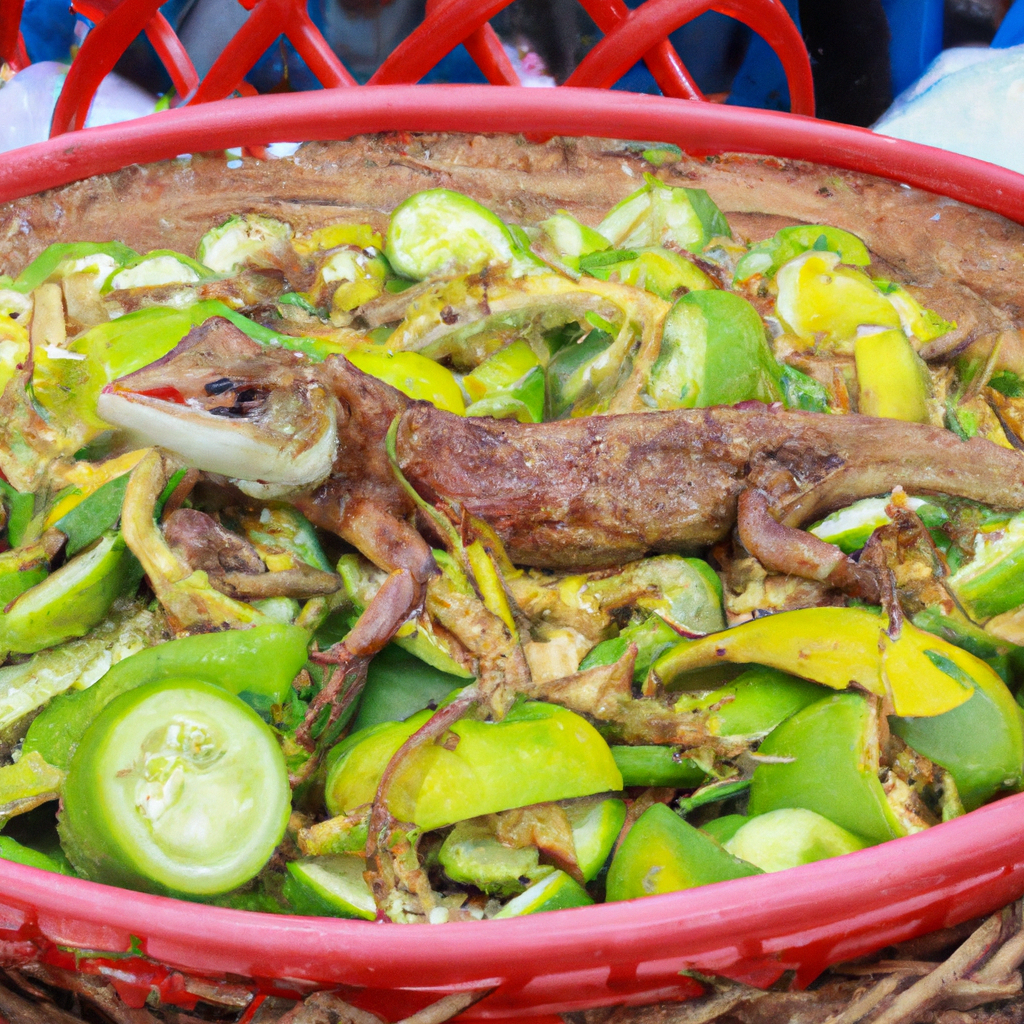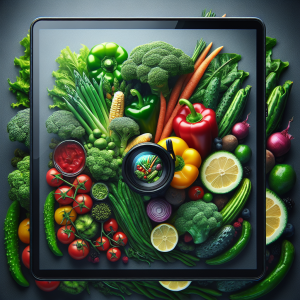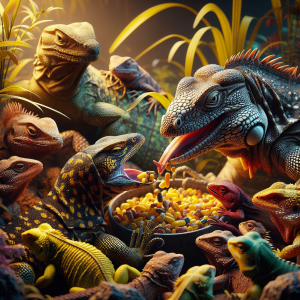Introduction: Homemade Lizard Food Recipes
Hey, did you know that creating homemade food for your pet lizard can have some surprising benefits? It’s not just about giving them a tasty meal – it can actually improve their health and happiness too! When you take the time to prepare homemade lizard food recipes, you have complete control over the ingredients you use, ensuring that your scaly friend gets all the nutrients they need to thrive.
Think about it – in the wild, lizards have a varied diet that includes insects, fruits, and vegetables. By replicating this diversity in their homemade meals, you can help mimic their natural diet and keep them healthy. Plus, commercial lizard foods can sometimes contain additives or preservatives that aren’t ideal for your pet’s well-being. By making your own food, you can avoid these potential harmful ingredients and provide a more wholesome diet for your lizard.
Not to mention, preparing homemade lizard food recipes can be a fun and creative experience. You can experiment with different ingredients and combinations to see what your lizard enjoys most. It’s a great way to bond with your pet and show them some extra love and care.
So, if you’ve been thinking about trying your hand at making homemade lizard food, go for it! Your pet will thank you for the tasty and nutritious meals, and you’ll enjoy the satisfaction of providing them with a diet that’s tailored to their specific needs. It’s a win-win for both you and your scaly companion!
Benefits of Making Homemade Lizard Food
You know, when I first started looking into making homemade food for my pet lizard, I was met with quite a bit of skepticism from friends and family. They were concerned that I might not be able to provide all the necessary nutrients and that it could be risky for my lizard’s health. But let me tell you, the benefits of making homemade lizard food far outweigh any challenges or controversies.
One of the main challenges that people often bring up is the time and effort required to prepare homemade lizard food. It’s true that it takes a bit of time initially to research recipes, gather ingredients, and prepare the meals. However, once you get into a routine, it becomes much easier and can even be quite enjoyable. Plus, knowing exactly what goes into your pet’s food and being able to tailor it to their specific dietary needs is incredibly rewarding.
Another common concern is whether homemade lizard food can provide all the necessary nutrients for your pet’s health. This is where careful planning and research come into play. By including a variety of ingredients such as leafy greens, vegetables, fruits, and protein sources like insects or lean meats, you can ensure that your lizard is getting a well-balanced diet. Consulting with a veterinarian or reptile nutritionist can also help address any concerns and ensure that your homemade meals are meeting your pet’s nutritional requirements.
Despite the challenges and controversies surrounding homemade lizard food, the benefits are undeniable. Not only can you save money in the long run by making your own food, but you also have full control over the quality and freshness of the ingredients. Plus, seeing your pet thrive on a diet that you have lovingly prepared yourself is a truly rewarding experience.
So, don’t let the naysayers discourage you. With a bit of dedication and research, you can provide your pet lizard with nutritious and delicious homemade meals that will keep them healthy and happy for years to come.
Essential Ingredients for Homemade Lizard Food
Let me tell you about the essential ingredients for making homemade lizard food. You know, when I first started making food for my pet lizard, I was a bit overwhelmed by all the different options out there. But as I did more research, I realized that there are a few key ingredients that are essential for creating a nutritious meal for our scaly friends.
One interesting fact about the ingredients is that each lizard species has its own dietary requirements. For example, some lizards are herbivores and need a diet rich in leafy greens and vegetables, while others are insectivores and require a diet high in protein from insects. It’s important to know what type of lizard you have so you can tailor the ingredients accordingly.
Now, when it comes to choosing the right ingredients, variety is key. You want to provide a balanced diet that includes a mix of protein sources, fruits, vegetables, and calcium supplements. Incorporating a variety of foods not only ensures that your lizard gets all the necessary nutrients but also keeps mealtime interesting for them.
One practical tip I learned along the way is to always wash and chop the ingredients thoroughly before preparing the food. This helps remove any pesticides or contaminants that could be harmful to your pet. Additionally, make sure to include gut-loaded insects if your lizard is insectivorous, as these provide essential nutrients for their diet.
So, the next time you’re whipping up a batch of homemade lizard food, remember the importance of choosing the right ingredients. By incorporating a variety of nutritious foods tailored to your lizard’s specific dietary needs, you can ensure that your scaly companion stays healthy and happy.
Step-by-Step Guide to Creating Homemade Lizard Food
**Option 4: Discuss a practical tip or advice related to IV.**
You know, when it comes to creating homemade lizard food, it’s all about getting the right balance of nutrients for our scaly friends. So, let’s dive into a practical tip that can make a big difference in ensuring your pet lizard’s health.
One crucial piece of advice when making homemade lizard food is to vary the ingredients you use. Just like us, lizards need a diverse diet to thrive. By incorporating a range of vegetables, fruits, and protein sources into their meals, you can provide them with a well-rounded nutrition profile.
For example, leafy greens like kale and collard greens are excellent sources of calcium and vitamins for lizards. Adding in some fruits like berries or melons can offer a sweet treat while providing essential vitamins. And don’t forget about protein – insects like crickets or mealworms can be a great source of protein for your pet lizard.
By mixing up the ingredients you use in your homemade lizard food recipes, you can help prevent nutrient deficiencies and keep your pet happy and healthy. Plus, offering a variety of flavors and textures can make mealtime more exciting for your lizard – just imagine them eagerly munching on a new dish you whipped up!
So, the next time you’re preparing a batch of homemade lizard food, remember to think outside the box and experiment with different ingredients. Your pet lizard will thank you for the delicious and nutritious meals you provide. And who knows, you might even discover a new favorite recipe that your scaly companion goes wild for!
Nutritional Considerations for Pet Lizards
Imagine you’re not just feeding your pet lizard but also playing the role of a master chef in a tiny reptilian kitchen. Yes, that’s the kind of adventure you can embark on when preparing homemade lizard food for your scaly friend. It’s not just about mixing up some ingredients; it’s about crafting a bespoke menu that will make your lizard’s taste buds (do lizards have taste buds?) tingle with joy.
As you dive into the realm of creating homemade lizard food, think of yourself as a wizard concocting magical potions in a cauldron. You’re not just following a recipe; you’re weaving spells of nutrition and flavor to delight your reptilian companion. Each ingredient you select is like a magic ingredient, contributing to the overall health and happiness of your scaly buddy.
Consider the process of preparing homemade lizard food as a fun experiment in your own mini laboratory. You get to blend veggies, fruits, insects, and other goodies to formulate the perfect meal that will keep your lizard thriving. It’s a science project, a culinary adventure, and a nurturing gesture all rolled into one.
Picture yourself as a lizard food artist, creating vibrant and appetizing dishes that would make any lizard food critic (if such a thing existed) give a standing ovation. Your kitchen becomes a creative space where you can innovate, adjust, and fine-tune recipes to cater to your lizard’s preferences and dietary needs.
So, as you embark on the journey of preparing homemade lizard food, don’t just see it as a chore; view it as a creative outlet, a delightful task that allows you to bond with your scaly companion in a unique way. Embrace the role of a lizard food artisan, and let your culinary skills shine in the reptilian realm.
Tips for Storing Homemade Lizard Food
You know, storing homemade lizard food may not sound like the most thrilling topic, but trust me, it’s a crucial part of the process! Picture this: you’ve spent time carefully preparing nutritious meals for your scaly friend, and now you need to make sure they stay fresh and safe to eat.
Think of storing homemade lizard food as a way to extend the love and effort you put into making it. By keeping the food properly stored, you can ensure that your pet gets the best possible nutrition while minimizing any risks.
Now, let’s dive into some practical tips for storing homemade lizard food. First off, always use airtight containers to store the food. This helps prevent any contamination and keeps the food fresh for longer. Make sure the containers are clean and dry before transferring the food to them.
Another important point is to label the containers with the date when the food was prepared. This way, you can keep track of how long the food has been stored and ensure you use it before it goes bad.
When it comes to refrigerating or freezing the food, remember that different ingredients may have varying storage requirements. Some foods may need to be kept in the refrigerator, while others can be frozen for longer shelf life. Be mindful of the specific needs of each recipe and adjust your storage method accordingly.
Lastly, always monitor the condition of the stored food. Check for any signs of spoilage, such as mold or unusual odors, and discard the food if you have any doubts about its safety.
By paying attention to how you store homemade lizard food, you can ensure that your pet enjoys fresh and nutritious meals every time. It may seem like a small detail, but it plays a significant role in keeping your scaly companion healthy and happy.
FAQ About Homemade Lizard Food Recipes
Let’s dive into some Frequently Asked Questions about Homemade Lizard Food Recipes. People often wonder about the best ingredients to use, how to ensure a balanced diet, and whether certain foods are safe for their scaly friends. One common question is, “Can I use fruits in homemade lizard food?” Yes, fruits can be a great addition to your lizard’s diet, but it’s essential to choose ones that are safe and nutritious for them. Avoid citrus fruits like oranges and lemons, as they can be too acidic for lizards’ stomachs. Opt for safe options like bananas, berries, and melons instead.
Another question we often hear is, “How long can homemade lizard food be stored?” Proper storage is crucial to maintain the freshness and safety of the food you prepare for your pet lizards. It’s recommended to store homemade lizard food in airtight containers in the refrigerator for up to three to four days. Freezing small portions can also help extend the shelf life of the food while preserving its nutritional value.
One more question that comes up frequently is, “Can I feed my lizard insects along with homemade food?” Absolutely! Insects are a natural part of many lizard species’ diets and can provide essential nutrients like protein. However, it’s crucial to ensure the insects are gut-loaded with nutritious foods before feeding them to your lizards. This means feeding the insects a healthy diet before serving them to your pets to ensure they pass on those nutrients.
By addressing these common questions and providing accurate information, you can feel confident in your ability to prepare homemade lizard food that meets your pet’s dietary needs. Remember, always consult with a reptile veterinarian or expert if you have specific concerns or questions about your lizard’s diet.
Homemade Lizard Food Recipes for Different Lizard Species
You know, when it comes to preparing homemade food for different lizard species, it’s essential to tailor the recipes to meet the specific dietary needs of each type of lizard. I remember the first time I tried making homemade food for my bearded dragon, Spike. It was quite a learning experience!
One practical tip I can share with you is to research the natural diet of your lizard’s species. Understanding what they would typically eat in the wild can help you create a more balanced and nutritious homemade meal. For example, bearded dragons are omnivores, so their diet should include a mix of insects, fruits, and vegetables. On the other hand, leopard geckos are insectivores, so their meals should primarily consist of insects like crickets and mealworms.
By incorporating this tip into your homemade lizard food recipes, you can ensure that your pet is getting the right nutrients they need to thrive. It’s all about mimicking their natural diet as closely as possible to promote their overall health and well-being.
Remember, experimenting with different ingredients and recipes can be a fun and rewarding experience. Don’t be afraid to get creative and try out new combinations to see what your lizard enjoys the most. And always keep an eye on their health and behavior to ensure that the homemade food is agreeing with them.
So, next time you’re whipping up a batch of homemade lizard food, keep this practical tip in mind to provide your scaly friend with a nutritious and delicious meal that they’ll love!
Enhance Your Pet’s Health with Homemade Lizard Food
Let me tell you about homemade lizard food recipes and why they are so important for our scaly friends. Creating your own lizard food allows you to tailor the ingredients to meet your pet’s specific dietary needs and preferences. It’s like being a gourmet chef for your lizard!
When I first started making homemade food for my lizard, I was amazed at how much he enjoyed the meals. Not only did he seem happier and more energetic, but his skin also looked healthier, and his colors became more vibrant. It was a rewarding experience to see the positive impact of homemade food on his overall well-being.
Did you know that different lizard species have varying nutritional requirements? By preparing homemade lizard food recipes tailored to your specific lizard’s species, you can ensure they are getting the right balance of nutrients essential for their health and vitality. It’s fascinating how a simple tweak in ingredients can make such a big difference in your pet’s diet.
One challenge that some lizard owners face when making homemade food is finding the time to prepare the meals regularly. But fear not! With proper planning and batch cooking, you can streamline the process and have a stash of homemade lizard food ready to go whenever your pet needs a fresh meal. It’s all about finding a routine that works for you and your scaly companion.
Have you ever wondered about the long-term benefits of feeding your lizard homemade food? Not only does it promote their health and well-being, but it also strengthens the bond between you and your pet. Sharing a meal that you’ve lovingly prepared can enhance the connection you have with your lizard, making mealtime a special experience for both of you.
So, why not give homemade lizard food recipes a try and see the positive impact it can have on your pet’s life? With a little creativity and effort, you can provide your lizard with nutritious and delicious meals that will keep them happy and healthy for years to come.
Additional Resources for Homemade Lizard Food Preparation
Have you ever wondered what goes into making nutritious meals for your pet lizard right at home? The idea of preparing homemade lizard food may seem intriguing, but you might be unsure where to start. That’s where homemade lizard food recipes come into play – offering you a simple and rewarding way to cater to your reptile friend’s dietary needs.
Creating homemade lizard food can be a fascinating journey filled with experimentation and learning. Imagine the satisfaction of watching your lizard eagerly devour a meal that you prepared with care and attention to detail. By delving into the world of homemade lizard food recipes, you have the opportunity to take your pet care skills to the next level.
As you explore the realm of homemade lizard food, you may encounter various questions. How can you ensure that the food you prepare meets your pet lizard’s nutritional requirements? What ingredients are safe and beneficial for different lizard species? How can you adapt recipes to suit your lizard’s preferences and dietary restrictions?
By engaging with homemade lizard food recipes, you not only provide your pet with wholesome and tailored meals but also deepen the bond between you and your reptilian companion. The process of preparing homemade lizard food can be a rewarding experience that allows you to connect with your pet on a new level.
So, are you ready to embark on a culinary adventure for your pet lizard? Explore the world of homemade lizard food recipes and discover the joy of creating nutritious and delicious meals that will keep your reptile friend healthy and happy.




